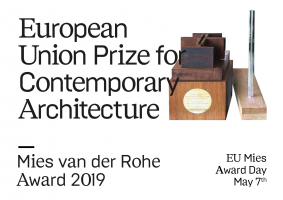
"What's old, What's new" Exhibition EUMies Award 2019
This exhibition shows the architectures that Dorte Mandrup, George Arbid, Angelika Fitz, Ștefan Ghenciulescu, Kamiel Klaasse, María Langarita and Frank McDonald have selected among the 383 works nominated for the EU Mies Award 2019 after hours of discussion and a week travelling around Europe. A diverse group that gathers 40 unique stories that are the result of a complex process over a period of time.
The winning and finalist projects are unfolded around a central core surrounded by the shortlisted ones. Through photos, videos, models, drawings and writings, multiple travels start: from small works embedded in rural areas to grand public space interventions in urban contexts; from devices that provide luxurious spatial experiences in public housing to experimental projects that go beyond the established regulations; from brand new buildings that trigger activity in old urban fabrics to innovative ways of dealing with pre-existing constructions.
Some of the thoughts that emerged from the jury's debates appear here as written quotes, inviting us to think about diverse new and old topics. These words are fragments extracted from a collection of texts gathered together in the EU Mies Award catalogue, a complementary tool to interpret a prize that celebrates contemporariness in architecture.
Different readings arise from these works and in the next months they will open different discussions once the exhibition starts travelling around the world. The publication Atlas. European Union Prize for Contemporary Architecture - Mies van der Rohe Award 1988-2015, for example, classified the works by type of intervention: new construction, extension or regeneration. In this cycle of the Award, over half the nominated works were self-classified as regenerations, a status that is also extensible within the selected works and to the group of finalists and winners. Regarding this situation, Ștefan Ghenciulescu, one of the members of the jury says: “there seems to be some general awareness of how the new is mainly a layer added on top of the old…”
We look forward to sharing these discussions with everybody, using all the tools available.
“To be contemporary is, first and foremost, a question of courage, because it means being able not only to firmly fix your gaze on the darkness of the epoch, but also to perceive in this darkness a light that, while directed toward us, infinitely distances itself from us. In other words, it is like being on time for an appointment that one cannot but miss ... The appointment that is in question in contemporariness does not simply take place in chronological time: it is something that, working within chronological time, urges, presses, and transforms it.”
Giorgio Agamben, philosopher
